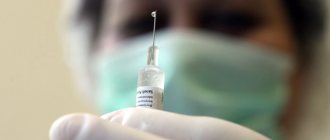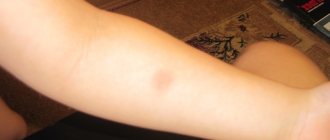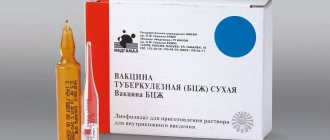The Mantoux test is the main means of determining predisposition to tuberculosis in preschool and primary school age. Fluorographic examination is already available for high school students. The main condition for obtaining the correct result is to perform the procedure on healthy children.
Therefore, it is worth considering what can affect the diagnostic result? Is it possible to make mantu after an illness? In what situations is this procedure contraindicated?
How is tuberculosis diagnosed in children?
The method of making manta for a child was created in order to test the young body in the most gentle way. This will allow tuberculosis to be identified at an early stage and treatment to begin before the disease leads to severe complications. This simple procedure involves introducing the pathogen under the skin of the arm from the inside of the forearm.
After three days, the doctor checks the injection site using several parameters:
- color;
- density;
- size.
A negative reaction to manta is determined by healthy skin color and the presence of only a trace of the injection on the surface of the skin. If there is slight redness and swelling from mantoux, the doctor may recommend repeating the procedure due to the dubiousness of the result.
A positive reaction in children is determined by the size of the injection site from 4 mm and the noticeable density of the papule. In the event of the formation of suppuration, a wound and swelling of more than 17 mm, the baby is urgently sent for additional examination and treatment with suspicion of an active form of tuberculosis.
What is mantu
Children are more sensitive to the causative agent of tuberculosis, so a vaccine is administered against this disease almost immediately after birth.
If this has not been done, then at 2 months it is necessary to carry out a tuberculin test, since there is a high probability of infection even without direct contact with the patient (in other cases this is done after a year, since the result may be false positive). Parents need to clearly understand that this is a kind of allergy test. It is not responsible for a person’s immunity from this disease, but only shows whether he has it.
To carry out the test, Tuberculin is used - a drug that is a combination of protein antigens that were obtained as a result of neutralizing the pathogen.
The procedure for this manipulation is as follows:
- First, the skin where the test will be performed is disinfected. This is the inside of the arm just above the wrist.
- After this, the syringe is placed parallel to the surface of the arm, after which a puncture is made in the skin and the product itself is injected under the skin, and not into the muscle.
As a result of these manipulations, a “button” is formed, based on the condition of which experts will draw conclusions.
It is safe, so it is given to all children, even if there is a medical outlet. Although there are still exceptions - children with allergies. In this case, consultation with a pulmonologist is required.
What could cause the results to be distorted?
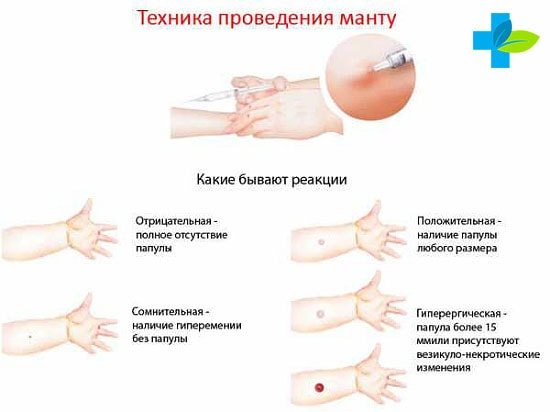
There are a number of factors due to which the mantoux reaction may be distorted. An incorrect diagnosis will prolong the examination time. Thus, you should not diagnose for tuberculosis if you have been vaccinated against another disease a short time before.
The presence of allergies or infectious diseases can also lead to a false diagnosis. A similar effect will occur even with a slight cough or runny nose. In addition to bacterial or viral infections, the diagnostic result in adults can be affected by rheumatism or a woman’s menstrual period.
You should notify your doctor about all such problems in advance.
The cause of a false reaction may be the quality of the drug. If the expiration date has expired or the storage conditions of the tuberculin test have been violated, it is strictly prohibited to administer manta using it. Compliance with technology during the procedure and evaluation of the results will be the key to the correct result. Therefore, only an experienced specialist can test.
The child is allergic. To vaccinate or not to vaccinate. 6 misconceptions of parents.
March 13, 2017
Vaccination is the creation of artificial immunity to certain diseases. Currently, this is one of the leading methods of preventing infectious diseases.
Infections against which vaccines exist are called manageable or controllable, and their incidence rate largely depends on the number of vaccinated people in the entire population. It is known that to achieve epidemic prosperity in the country, at least 95% of the population must be vaccinated. This means that not only healthy people are subject to vaccination, but also people suffering from various diseases, including allergies.
At the same time, every year there is a significant increase in allergic diseases throughout the world. International statistics show that over the past two decades the incidence of allergic pathology has increased 3-4 times. Every fifth person on our planet suffers from allergies. Allergic rhinitis, conjunctivitis occurs in 4-20% of the population. Bronchial asthma affects 5-15% of the entire world population. Atopic dermatitis accounts for 20-30% of all allergic diseases in children. Every second person in the world has suffered an episode of urticaria at least once in their life.
Conversations about the necessity and dangers of vaccinations flare up and then die out among parents of allergy sufferers. There are voices calling for a complete abandonment of broad immunoprophylaxis in order to “preserve the health of children.” To dispel the doubts and misconceptions of parents of children suffering from allergies, this article has been prepared.
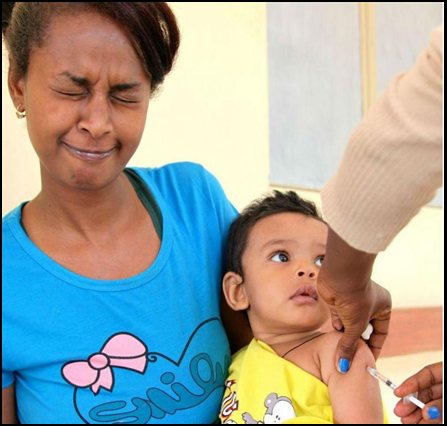
Misconception No. 1
Preventive vaccinations are contraindicated for persons suffering from allergic diseases. Children and adults with allergic diseases should receive preventive vaccinations against all infections included in the National Schedule of Preventive Vaccinations. However, vaccination of these patients is carried out in compliance with certain rules. Vaccination of persons with allergic diseases is carried out upon achieving complete or partial remission, upon achieving control of the course of allergic pathology, including against the background of basic therapy. Such patients should be more carefully examined and examined before vaccination, and observed after vaccination. Very often, preventive vaccinations for patients with allergic diseases are carried out under the “cover” of antihistamines, which minimizes the risk of adverse reactions in such patients. Management tactics are based on an individual approach to each patient. Patients with a burdened allergic anamnesis, together with the local pediatrician, must be consulted by an allergist-immunologist; if necessary, correction of the basic and symptomatic therapy of the allergic disease is carried out; a decision is made on the timing of vaccination, the volume of medication preparation and the choice of vaccine drug. For example, patients with hay fever (seasonal allergic rhinitis and conjunctivitis) are vaccinated outside the dusting season of trees and grasses, patients suffering from drug allergies are prescribed preventive vaccinations after a short course of antihistamines, patients with manifestations of food allergies are vaccinated against the background of a strict hypoallergenic diet .
Misconception #2
Vaccines used for immunoprophylaxis “allergize” the human body.
Modern vaccines, both live and inactivated, promote the body's production of protective anti-infective antibodies - immunoglobulins of classes G and M; at the same time, they practically do not increase the level of total immunoglobulin E and the production of specific IgE antibodies involved in the formation of allergopathology.
Misconception #3
Adverse reactions that develop after preventive vaccination are a contraindication to further vaccination.
Post-vaccination reactions and post-vaccination complications should be distinguished. Post-vaccination reactions include increased body temperature and the appearance of lumps of various sizes at the injection site. Such phenomena are not contraindications for further vaccination, but should be taken into account by the doctor to determine further immunoprophylaxis tactics. So, for example, if post-injection thickening of the gluteal region occurs, the next vaccination should be performed in the area of the outer surface of the thigh or the upper third of the shoulder.
Post-vaccination allergic complications in the form of a generalized allergic reaction or anaphylactic shock are absolute contraindications for vaccination with the same vaccine or a vaccine containing a causative component. So, for example, if edema and urticaria develop after administration of AS toxoid, the use of DPT vaccine and ADSM toxoid is contraindicated. Carrying out preventive vaccinations against hepatitis B and influenza in this case has no contraindications.
It should be remembered that patients who are allergic to chicken egg whites are a contraindication for vaccination with influenza, measles, and mumps vaccines, since these vaccines are prepared on a chicken substrate. These vaccines also contain traces of aminoglycoside antibiotics, which is important to consider as a contraindication for patients who have systemic allergic reactions to antibiotics.
Misconception #4
For patients suffering from allergic rhinitis and bronchial asthma, flu vaccinations are contraindicated, as they aggravate the course of the underlying disease.
Patients with chronic diseases of the respiratory system are at risk of adverse consequences from acute respiratory viral infections and influenza. In children and adults with allergic diseases of the respiratory system, it is advisable to expand the schedule of preventive vaccinations by vaccination against pneumococcal infection and annual vaccination against influenza. Vaccination against these infections reduces the incidence of influenza and pneumonia, the frequency and severity of exacerbations of the underlying disease, which makes it possible to lengthen the period of remission of chronic bronchopulmonary pathology and achieve a reduction in the volume of basic therapy.
Misconception #5
The use of combined vaccines for people suffering from allergic diseases is not advisable, since multicomponent vaccines are more likely to cause unwanted reactions.
Most inactivated vaccines contain additional substances - adsorbents (adjuvants) and preservatives (stabilizers). They are often the cause of local reactions in the form of swelling and hyperemia of the skin. Therefore, the use of combined vaccines makes it possible to reduce the total volume of administered preservatives, which reduces the number of post-vaccination reactions. For example, the use of the Pentaxim vaccine allows for vaccination against whooping cough, diphtheria, tetanus, polio and hemophilus influenzae and replaces the administration of several injections of vaccine preparations.
Misconception #6
If a child has allergies, the Mantoux test should not be done, because... it will not be informative.
First of all, it is worth saying that the Mantoux test is not a vaccination, i.e. it does not protect the body from tuberculosis, but tests for its presence. The thing is that tuberculosis is often asymptomatic, affecting not only the lungs, but also other organs and systems, and even some parts of the brain; more often this happens when the body’s defenses are reduced.
What will be a decrease in immunity for atopic children? Of course, any exacerbation of the disease weakens the body, which is the reason for the start of the infectious process. That is why experts recommend performing all Mantoux tests in a timely manner, the results of which allow timely diagnosis of possible risks of a serious disease.
The substance “Tuberculin” itself is an allergen for the human body, therefore, an allergic reaction in the form of redness is often observed at the injection site, so it is often regarded as a false-positive test result, so additional examination may be required.
Features of caring for the injection site
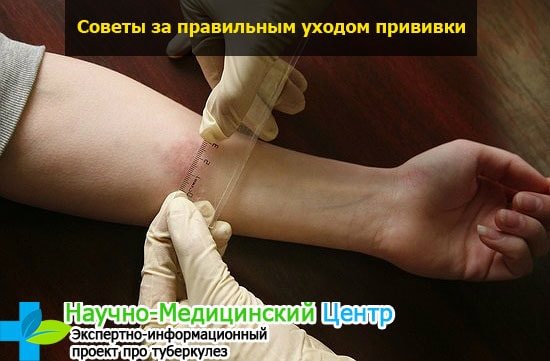
The reaction to tuberculin is checked some time after administration of the drug. Therefore, it is worth following some rules for caring for the injection site. So, it should not be covered with any means, be it body cream, iodine or other external application. Although, contrary to popular belief, water does not have any effect on the test result, it is best to avoid contact with it and other liquids.
Squeezing, friction or exposure to sweat can distort the result of mantoux. Therefore, until the reaction is checked, you should not wear tight, constricting clothes.
Or cover the injection site with a plaster or other means. Although the graft may be itchy, you should not scratch it. Such manipulations will only intensify the allergic reaction. Applying these simple rules along with other precautions will protect against the consequences of a false mantoux reaction.
What to replace
Mantoux is not the only method for detecting tuberculosis. You can use Diaskintest instead. This technique is similar to Mantoux, but only with Diaskintest, a drug of the same name is injected subcutaneously - Diaskintest. Tuberculin administered with Mantoux is a natural antigen, and Diaskintest is synthetic. This method is more accurate: the resulting reaction is not interpreted in two ways.
Another way to detect the disease is the Suslov test. When using it, nothing is injected into the human body, but blood is taken from a finger. The biomaterial and tuberculosis pathogens are placed on laboratory glass. Interacting with each other, they form a pattern by which the doctor determines the presence of Koch’s bacillus in the body.
The disadvantage of this method is its low accuracy, no more than 60%.
Unlike a blood test, a genetic test gives a more accurate result. The method of its implementation is based on the polymerase chain reaction, enzyme-linked immunosorbent assay or immunoleukocytosis reaction. If the biomaterial taken from the subject contains at least one molecule of a pathogenic microorganism, this will be reflected in the analysis.
When the mantoux test is contraindicated
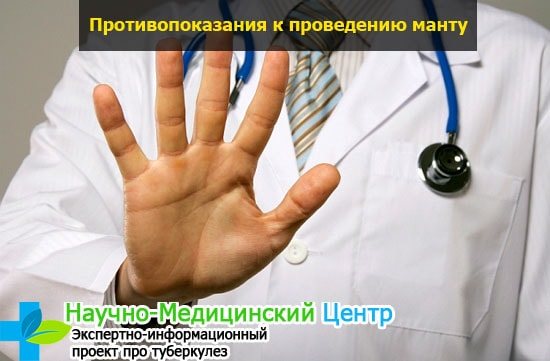
There are a number of conditions under which manta rays need to be transferred or replaced with another diagnostic method:
- various types of dermatitis;
- exacerbation of chronic infection;
- presence and activity of somatic diseases;
- mental disorders including epilepsy;
- vaccinations given in the last month before the intended introduction of tuberculin;
- respiratory diseases or weakened immunity for other reasons.
You must notify your doctor about all these contraindications in order to issue a medical exemption. Depending on the situation, he will appoint another day when you can place the manta. Or he will choose another way to test the body for a predisposition to tuberculosis.
What is a medical outlet from Mantoux
Medical withdrawal is a temporary or complete refusal to perform the Mantoux test; such a decision is made only by the pediatrician based on the results of the examination of the child. The independent decision of parents to refuse such a diagnosis of tuberculosis is not a medical decision.
Watch the video on how to refuse the Mantoux test:
The Mantoux test itself does not lead to disease, but in some cases it is better to exclude the administration of tuberculin, because the results can be false positive, and the risk of complications under certain conditions becomes high.
Mantoux after illness
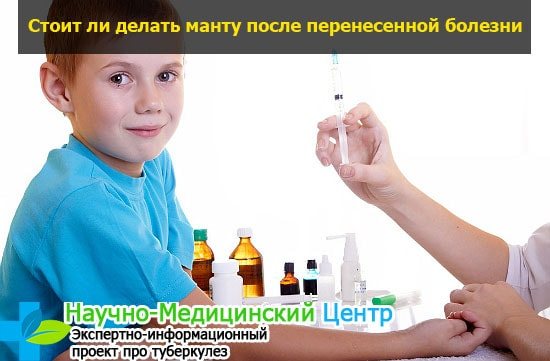
Since it is not worth putting manta immediately after an illness, it is important to know how much time you need to wait before the procedure. This factor depends on the characteristics of the disease.
It is recommended to give mantu to children after ARVI 2 weeks after complete recovery. With chickenpox, the recovery period for a young body is extended to a month. After discharge, a medical exemption must be issued for 3 months. And if after this time period the test result is doubtful, additional examination by a TB specialist will be required. After measles, it will take at least 45 days to restore immunity.
It is necessary to be especially careful regarding vaccinations and other diagnostic procedures if the child’s body is affected by a viral disease called mononucleosis. A feature of this disease is damage to the cells on which immunity depends. Therefore, during the entire recovery period, the child will be susceptible to colds and other infections. And any contact with tuberculin can cause infection.
Preliminary consultation
Even after complete recovery, situations arise when a preliminary consultation with a doctor is necessary. At the appointment, the patient is required to have their body temperature measured. If it rises even a few degrees above normal, diagnosis should be postponed; perhaps there is an infection in the body. The doctor will also ask if the throat hurts, if there is any discharge from the nose, and how the patient is feeling.
You should contact a therapist in the following cases:

if a rash, redness, itching appears on the body - any allergic reaction of unknown etymology, especially at the site of the intended injection;- feeling unwell (cold);
- digestive tract disorder;
- an epidemic of a disease is spreading in the patient’s area of residence and quarantine has been declared;
- pneumonia;
- chicken pox;
- stomatitis;
- conjunctivitis.
Any medication taken can affect the result of tuberculin diagnostics. In this case, you also need to consult a doctor.
Patients with epilepsy and women during menstruation are not given Mantoux. After any vaccination, a tuberculin injection is administered no earlier than a month later.
Consequences of introducing tuberculin into a weakened body
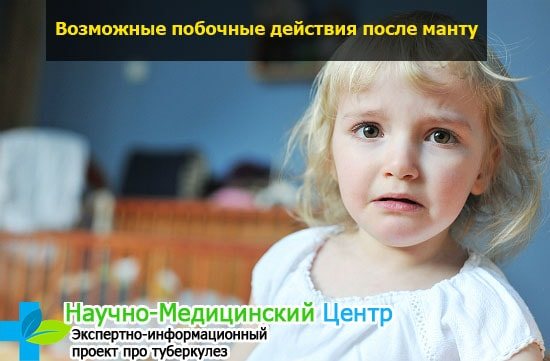
When determining how long after an illness one can make mantu, a wise doctor will think about the consequences of haste in this matter.
Tuberculin introduced into a weakened body can lead to the following consequences:
- acute signs of a cold in the form of cough and runny nose;
- attacks of nausea and vomiting;
- signs of cephalalgia;
- dizziness;
- increased body temperature, manifested in the form of chills or fever;
- skin rashes;
- with complications of an allergic reaction, angioedema or anaphylactic shock are possible;
- diarrhea or stool retention.
Early diagnosis of tuberculosis is very important. But you shouldn’t risk your health by trying to speed up the diagnostic process.
Factors distorting the results
To obtain a reliable result, when performing the Mantoux test, it is necessary to exclude distorting factors.
For example, the detection of a false-positive reaction of the body can be recorded in case of individual intolerance to the components of tuberculin, during infectious diseases, or if the child has relatives suffering from tuberculosis. Also, incorrect results are often obtained in the absence of routine BCG vaccination.
Mantoux and colds
Is it possible to make Mantu for a cold? Will this lead to false positive results and harm the baby's health? These questions worry many parents. And, according to doctors, it is not worth carrying out a diagnostic test if there are signs of a cold.
And this is explained not only by obtaining incorrect results, but also by an increased risk of the child developing complications due to acute respiratory infections. After the test, the baby’s body’s defenses weaken and he can no longer cope with the virus.
But there is still debate among scientists regarding the duration of the delay in conducting the test. Some argue that Mantoux can be performed already on the 10-14th day after the development of a cold, and even the presence of a slight runny nose does not matter.
But others are in favor of the idea that it is better to postpone the test until complete recovery, since before testing the child’s body, it needs to be given time to recover.
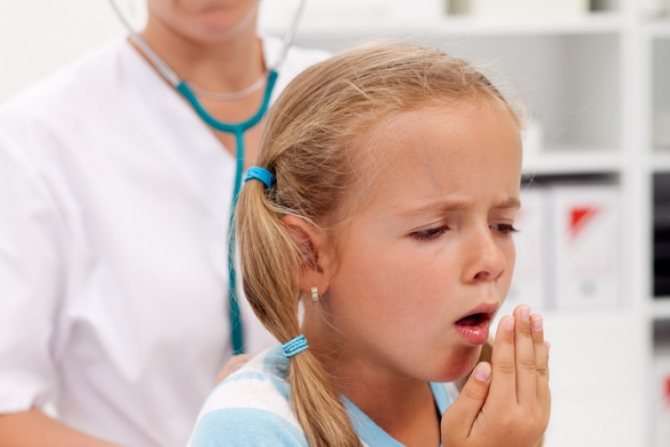
Cough, high body temperature, weakness and runny nose are contraindications to the Mantoux test. However, not only signs of a cold can worsen the baby’s condition after the injection.
A completely healthy child’s body can also give an inadequate reaction to the introduction of tuberculin. It can manifest itself with various symptoms, for example:
- an increase in temperature to subfebrile;
- loss of appetite;
- drowsiness;
- weakness;
- dizziness.
Misconceptions and Myths
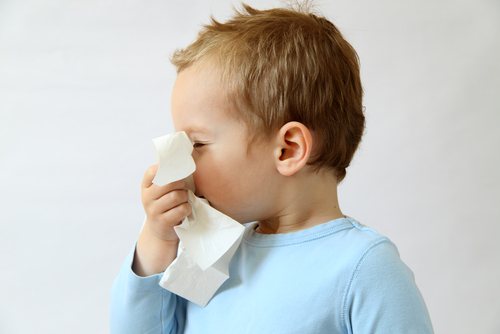
As a rule, this is observed during the incubation period of a cold or if the child has chronic diseases. In addition, if the baby is allergic, after the vaccination an allergic reaction may occur, which manifests itself in the form of rhinitis, lacrimation, redness of the eyes and swelling of the eyelids. There is an opinion among parents that conducting tuberculin diagnostics significantly increases the risk of developing tuberculosis. However, according to experts, during the Mantoux test, a small amount of tuberculin containing killed bacteria is injected under the skin, which is quickly suppressed by the antibodies of the immune system, so you cannot get sick from the injection itself.
But after it, the body’s protective properties weaken, which increases the likelihood of infection. That is, a child may well catch tuberculosis, but not from vaccination, but after it due to weakened immunity.
There are certain conditions that may well arise after tuberculin diagnostics, requiring increased monitoring and visits to a doctor. These include:
- intestinal disorders (diarrhea, constipation);
- vomit;
- local rashes, inflammatory and purulent reactions.

And the symptoms described above are not uncommon. However, they are considered normal if they are observed for no more than 2 days and are not pronounced. But if low-grade fever, weakness, poor appetite and other signs last longer than 2 days, while the general clinic is supplemented by a cough or allergic reactions, the child urgently needs to be shown to a doctor. The Mantoux test is not a contraindication to the introduction of a normal lifestyle. The baby can safely attend preschool institutions, walk and swim. However, for the first 24 hours after vaccination, it is recommended to adhere to a gentle regimen.
There are few conditions in which the Mantoux test is contraindicated. But if a child has a cold with pronounced clinical signs, a tuberculin test cannot be performed. This is explained by the presence of a large number of viruses and bacteria in the body. And if tuberculin is introduced at this moment, the immune system will direct all its forces to its elimination, and at this time infectious agents will actively multiply, leading to the development of serious complications.
Mantoux after illness

It all depends on the child’s immune system and his general condition. If the doctor decides that the child’s body is not yet able to adequately respond to a tuberculin test, he will prescribe a medical discharge. Its duration depends on several factors: the nature of the disease and the stage of its development. For example, for a cold, the maximum delay is 30 days from the moment of complete recovery.
If a child develops a complication in the form of pneumonia due to a cold, then in this case the medical withdrawal is extended to 60 days. In case of viral diseases (for example, chicken pox), the Mantoux test is postponed for 5-6 months, and in the presence of mononucleosis - for 1.5 years.
In any case, you should not agree to carry out the test already on the 2nd or 3rd day after the disappearance of cold symptoms. The immune system is still weakened, and the injection can provoke not only the re-development of the disease, but also the occurrence of serious complications.
Who makes the decision to postpone the procedure?
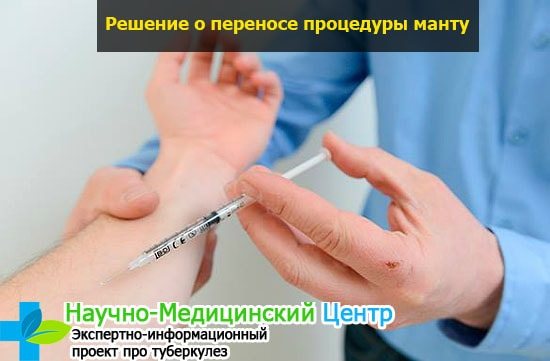
The decision about when to make mantu after a child’s illness is made by the parents. Medical facility workers cannot begin performing the procedure without their consent. You can agree to or refuse a procedure only after consultation with your doctor.
Let's summarize: the mantoux test is one of the main methods for diagnosing predisposition to tuberculosis. However, it should not be done in the presence of respiratory and a number of other diseases that weaken the immune system, or immediately after recovery.
Violation of this requirement leads to a number of undesirable consequences. The type of illness will determine how many days later it is possible to carry out diagnostics in a safe mode. And does it make sense to replace the subcutaneous injection of a tuberculin test with another method.
Can a child get tuberculosis after Mantoux?
After Mantoux, a child cannot get tuberculosis - this is the categorical answer of official medicine to a frequent question from parents . The fact is that it is not the causative agent of the disease that is introduced into the body, but the killed waste products of mycobacteria.
The extract undergoes multi-stage processing:
- heating to the highest possible temperatures;
- presence in acid vapors;
- stay in ethanol and ether.
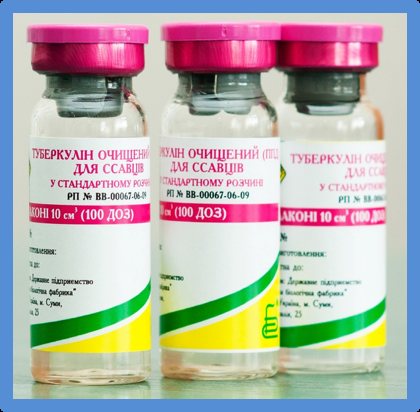
After such aggressive influences, the bacterium becomes absolutely harmless to the body, it is not active and cannot cause the development of tuberculosis.

